Prehistoric people are human beings who lived before the invention of writing, which occurred about 5,500 years ago. Writing enabled people to record information, including descriptions of events in their lives. These written descriptions make up history. The period before writing is called prehistory, and people who lived during this time are known as prehistoric people.
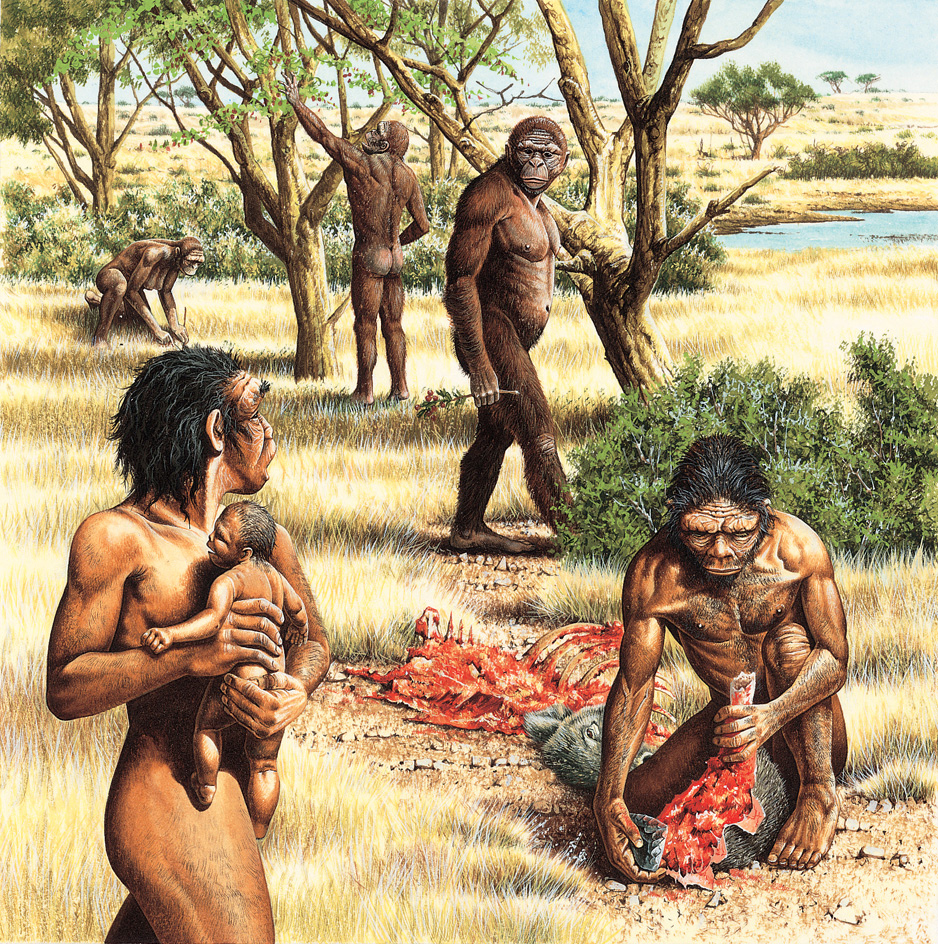
The first human beings lived about 2 million years ago. They descended from even earlier ancestors, small humanlike creatures who walked with an erect (upright) posture. Scientists call all members of the human lineage hominins. This article will discuss prehistoric people and their ancestors and how the human lineage has changed over 7 million years.
The scientific study of prehistoric people began during the 1700’s. People in Europe sometimes found evidence of humans who lived long before the ancient Greeks and Romans. Such evidence included stones that appeared to have been chipped into axes and other tools. Scholars theorized that people had made these stone tools before the invention of bronze or iron, long before the earliest recorded history. By the early 1800’s, people had discovered fossilized bones of prehistoric humans. These ancient people seemed to have lifestyles and appearances different from those of living people.
As more fossils were collected, scholars began to assemble a clearer picture of early people. For example, scientists learned from fossil evidence that early human beings had brains smaller than those of most modern people. This difference provided evidence that humans had evolved—that is, their biological makeup had changed over time. As the environment of the prehistoric world changed, our prehuman ancestors went through many changes. The first human beings were suited to their ancient environment, and over time, they changed their way of life. As they did, modern human beings evolved.
Today, many kinds of scientists work together to learn about prehistoric people. Physical anthropologists examine the fossilized bones and teeth of prehistoric people and their prehuman ancestors. Archaeologists search for and examine evidence such as pottery and tools to help explain how prehistoric people lived. Botanists study the remains of prehistoric plants, and zoologists analyze fossils of animals that lived at the same time as prehistoric people. Geologists study the rock in which fossils are found. All these scientists are called paleoanthropologists if their chief concern is the study of human physical and cultural development.
Evidence of prehistoric people—such as fossils, tools, and other remains—is rare and often fragmented. Evidence of the earliest types of prehistoric people is the most difficult to find. Paleoanthropologists must base their theories on this limited evidence. As a result, scientists cannot yet present a detailed picture of early human life. Over time, new discoveries can provide evidence to disprove previous theories.

Prehuman ancestors
Scientists understand that humans and apes—such as bonobos, chimpanzees, and gorillas—share a common ancestor. Evidence for this conclusion comes from studies comparing the physical structure and genetic makeup of human beings and apes. Genes are the basic units of heredity. They determine what traits living things inherit from their parents. Genes are encoded within the structure of a molecule called DNA (deoxyribonucleic acid). Human DNA differs from that of chimpanzees and bonobos by about 2 percent. Many human genes are almost identical to those in chimpanzees. Most differences in other genes are small. This shared DNA reflects our shared ancestry. DNA affects all aspects of our biology, including the function of cells, how we grow and develop, the shape of our bones, and the structure of our brain. Studies of anatomy also show that people are more similar to apes than to any other living animal.
The common ancestor of chimpanzees, bonobos, and human beings was an apelike creature that lived between about 10 million and 7 million years ago. Scientists have determined this by measuring differences in DNA between apes and modern humans and comparing this to the rate at which DNA changes. Scientists have also discovered fossilized remains of humanlike creatures who lived up to 7 million years ago. The fossil evidence for human evolution includes thousands of ancient bones discovered over the last 200 years.
Humans are unique among living primates in that we make extensive use of walking on two legs, a type of movement called bipedal locomotion. Apes, by contrast, tend to support themselves with their knuckles as they walk. In human beings, bipedal locomotion has brought about several changes in anatomy, especially in the bones and muscles of the hips and legs. Paleoanthropologists know from fossil hominins that bipedal locomotion evolved very early in our ancestry. They look for anatomical evidence of bipedal locomotion when deciding whether to classify a fossil in the hominin lineage.
The earliest hominins.
For most of their existence, hominins lived only in Africa. Scientists have not discovered a fossil hominin more than 2 million years old outside of Africa. Fossils from different parts of Africa provide evidence of how three of the earliest kinds of hominins may have looked and lived. These fossils share a mix of humanlike and apelike characteristics. The anatomy suggests that early hominins carried their spines and heads in a more upright position compared with those of chimpanzees or gorillas. Two early hominins have fossils that show that the legs were sometimes used to stand or walk upright. All three hominins have small canine teeth compared with those of apes. Canine teeth are the sharp, pointed teeth at the front corners of the mouth.
Paleoanthropologists discovered fossil evidence of the earliest known hominin in 2001 in the Djurab Desert, near Faya-Largeau, in the African nation of Chad. The skull of this apelike creature—called Sahelanthropus tchadensis << sah hehl AN throh puhs cha DEHN sihs >> —is the oldest to show evidence of upright posture and smaller canine teeth. The fossils are between 6 million and 7 million years old. Fossils of another early hominin, called Orrorin tugenensis << aw RAWR ihn too guh NEHN sihs, >> were discovered in Kenya in 2000. The fossils, which are about 6 million years old, show leg bone changes related to upright walking.
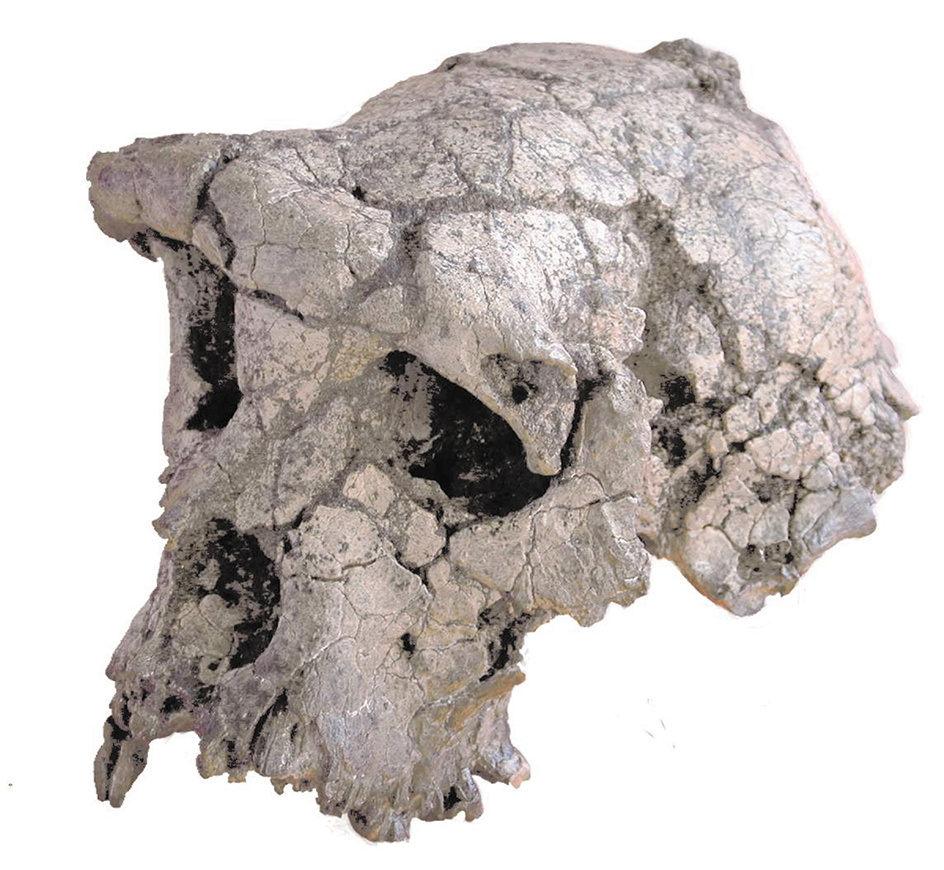
The third kind of early hominin includes Ardipithecus ramidus and Ardipithecus kadabba << kuh DAH buh >>, both of which lived in what is now Ethiopia in northeast Africa from about 5.8 million to about 4.4 million years ago. A fossilized partial skeleton of A. ramidus preserves evidence of the feet, legs, hips, arms, hands, and skull. The hands and feet were apelike and well suited for climbing trees. But A. ramidus also had small canine teeth and hips more suited for bipedal walking.
The scientific names of these early hominins have special meanings. Ardipithecus comes from words meaning ground ape in ancient Greek and in the Afar language of Africa. The name Orrorin means original man in the language of the people of the Tugen Hills region of Kenya, where the fossils were found. The name Sahelanthropus tchadensis comes from Greek and Latin words meaning Sahel man of Chad.
Scientists are not sure how the earliest fossil hominins are related to later hominins. The early fossil remains are rare, incomplete, and fragmentary. The geology of many parts of the world does not preserve any fossils from the time of the earliest hominins, nearly 7 million years ago. Scientists study our ancestry by comparing the anatomy of early fossils to that of modern humans. Scientists then construct a kind of “family tree” illustrating relationships among the species.
The australopithecines.
A much better-understood group of early hominins is the australopithecines << aw stray loh PIHTH uh seenz >>. The australopithecines are classified in the genus Australopithecus, a word that means southern ape. They first appeared about 4 million years ago in Africa. Fossil evidence suggests that these creatures became extinct between 2 million and 1 million years ago, after the first human beings appeared. Scientists have found australopithecine fossils in eastern, southern, and north central Africa.
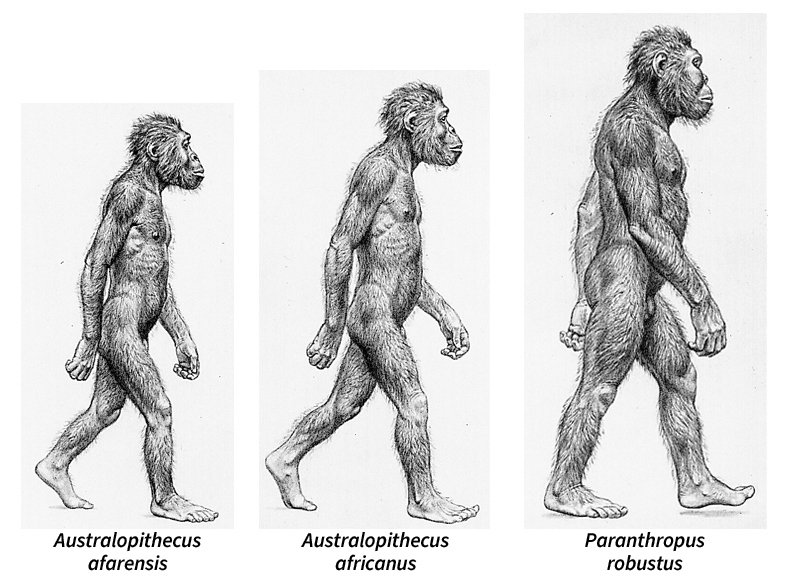
Appearance.
The australopithecines could stand and walk upright much like humans. Their skeletons had changed in many ways to support bipedal locomotion. Like humans, they had feet with arches and a big toe in line with the others. Their hip and leg bones show that they had muscles oriented to make bipedal locomotion easier and more efficient. Like humans, australopithecines had an S-shaped spine, with the head sitting on top of the spine instead of hanging in front, as it does in apes. Like both humans and earlier hominins, australopithecines had canine teeth smaller and less pointed than those of living apes.
The australopithecines had large faces that jutted out in front of their foreheads, compared with the relatively flat faces of human beings. Australopithecine brains were only one-third the size of modern human brains. The analysis of fossils suggests that australopithecines matured quickly, as do apes, with a shorter childhood than that of people.
Australopithecine molars (back, chewing teeth) were large, flat, and suited to grinding food. Australopithecines had a broad diet, evidenced by the shape of their teeth, the chemistry of their bones, and preserved plant remains on the teeth. Their diet included fruits, vegetables, nuts, seeds, insects, and even small animals.
Types.
Most scientists have divided the genus Australopithecus into eight species based on differences in overall size and in the shape and size of the jaws, teeth, and brain. The eight species are (1) Australopithecus anamensis, (2) A. afarensis, (3) A. africanus, (4) A. garhi, (5) A. robustus, (6) A. aethiopicus, (7) A. boisei, and (8) A. sediba. Differences in skulls and teeth among the species reflect important differences in diet and lifestyle.

The earliest known species was A. anamensis << an uh MEHN sihs >>, which lived in what is now Ethiopia and Kenya around 4 million years ago. A. afarensis << af uh REHN sihs >> appeared about 3.7 million years ago. One of the most complete australopithecines that scientists have found is a partial skeleton of a female A. afarensis. It was found at Hadar, Ethiopia. Scientists estimate that this individual, whom they nicknamed “Lucy,” stood about 3 1/2 feet (110 centimeters) tall and weighed about 70 pounds (30 kilograms). Scientists also have discovered the fossilized footprints of A. afarensis individuals at Laetoli, in Tanzania. The footprints resemble those of modern people and show that A. afarensis walked bipedally. However, these hominins had arms that were longer in proportion to their bodies than are those of modern humans. A. afarensis had a brain about the size of a chimpanzee brain. In 2015, paleoanthropologists announced the discovery of fossils of a new australopithecine species, A. deyiremeda. This species lived at the same time and in the same region as A. afarensis.

By about 3 million years ago, another australopithecine, A. africanus, lived in southern Africa. These creatures had rounder skulls and slightly larger brains than did A. afarensis. In 1998, a complete skeleton of A. africanus was discovered at Sterkfontein, a fossil site near Johannesburg, South Africa.
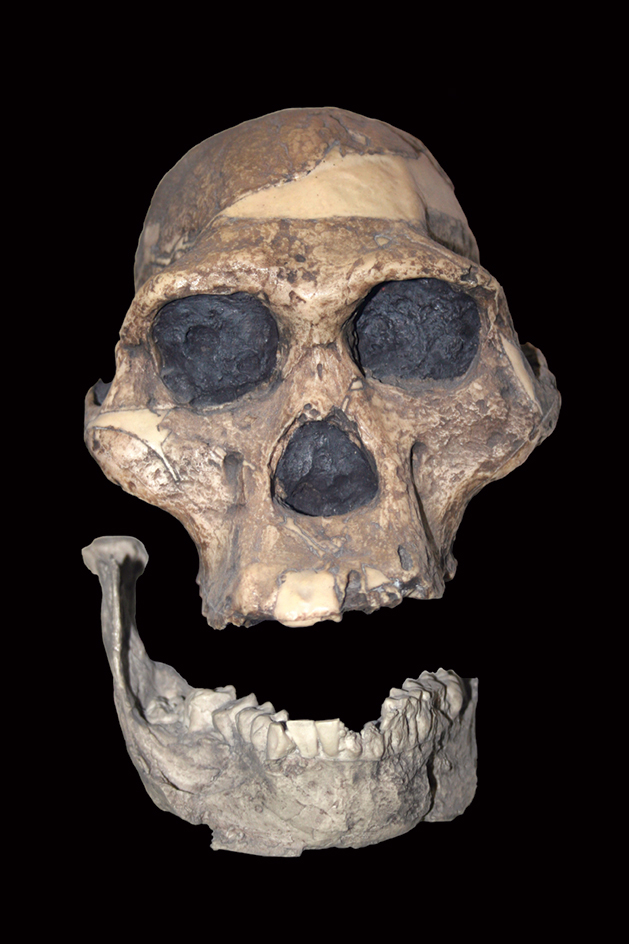
A. afarensis and A. africanus include large numbers of fossils representing many individuals. For more than 2 million years, the anatomy of australopithecines stayed much the same. All of them had small bodies, used bipedal locomotion, and had long arms suitable for climbing. The differences among them were in the skull and were due to different dietary habits.
During the time of A. africanus, more australopithecine species appeared. One of them, A. garhi << GAH ree >>, lived in northeastern Africa. A. garhi resembled A. afarensis but had larger teeth.
Two other australopithecines, P. aethiopicus << `EE` thee OH pih kuhs >> and P. boisei << BOY zee eye >>, lived in eastern Africa. Still another, A. robustus, lived in southern Africa. Scientists call these three species the robust australopithecines. They had much larger molars and more powerful jaws than did the other Australopithecus species. These features probably helped them to eat tougher food. The robust australopithecines had a brain size similar to that of A. africanus.
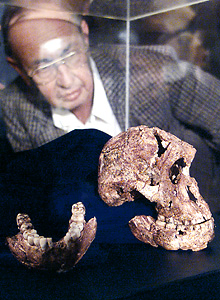
Australopithecus sediba was a South African hominin that lived about 2 million years ago. Fossils of this species were first found in 2010 at a small cave called Malapa, near Sterkfontein. Scientists know the anatomy of this hominin from two partial skeletons found at Malapa. The evidence shows how different parts of the skeleton may evolve at different rates and in different patterns, a process called mosaic evolution. A. sediba had a small body and brain like those of an ape. Other features, including parts of the face, teeth, hips, and hands, were more humanlike than those of any other australopithecine. Some paleoanthropologists think this shows that A. sediba is more closely related to the ancestor of humans than are other australopithecines.
Scientists are uncertain about precise relationships among the australopithecines. Most scientists think the robust australopithecines formed a side branch to the evolutionary tree linking other australopithecines. Some scientists think the other species, called gracile australopithecines, evolved one after another, from the earliest, A. anamensis, to the most recent, A. sediba. Other scientists think that the australopithecine species were linked differently. They believe that the physical differences resulted from different regional diets, rather than representing a steady progression.
Another hominin species that lived at the same time as Australopithecus is Kenyanthropus platyops << kehn yuhn THROH puhs PLAT ee ops >>. It is known from a single fossil skull discovered in Kenya in 1999. The term platyops means flat and refers to the relatively flat, nonprojecting face of this creature. A relatively flat face is a physical feature also seen in early human beings.
Eventually, all the australopithecines went extinct. Scientists have not found any australopithecine fossils dated more recently than about 1 million years ago. The robust australopithecines survived the latest. Scientists do not think that these australopithecines were the direct ancestors of humans. But they do not yet know for certain which australopithecines were our direct ancestors.
The first human beings
The first human beings lived in Africa about 2 to 2.8 million years ago. Paleoanthropologists have found important fossils of these people near the shores of Lake Turkana in Kenya and in Olduvai Gorge in Tanzania. Many scientists divide these people into three species—Homo habilis, Homo rudolfensis, and Homo erectus. The Latin word Homo refers to human beings.
In 2015, paleoanthropologists announced the discovery of fossils at a site called Rising Star cave in South Africa that may represent a previously unknown species of early humans. The scientists named this new species Homo naledi. Scientists do not yet know how old the fossils are, however, nor how these people were related to other humans.
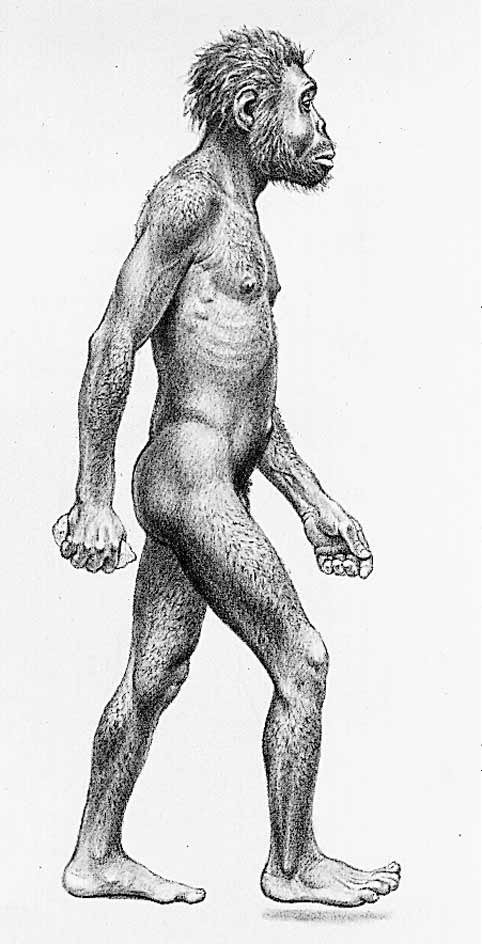
Homo habilis and Homo rudolfensis.
The most significant trend in the evolution of the human genus, Homo, was the development of a larger brain. Around 2 million years ago, hominins appeared that had brains larger than those of australopithecines, yet only about half the size of modern human brains. Homo habilis << [hoh] moh HAB uh luhs >>, discovered at Olduvai Gorge, had smaller molars and a less protruding face than did the australopithecines. The term habilis means handy or skillful.
Homo rudolfensis had a brain larger than that of H. habilis. It also had large molars, like those of the australopithecines. The term rudolfensis comes from Lake Rudolph, an old name for Lake Turkana. Fossils of H. rudolfensis have been discovered near the lake.
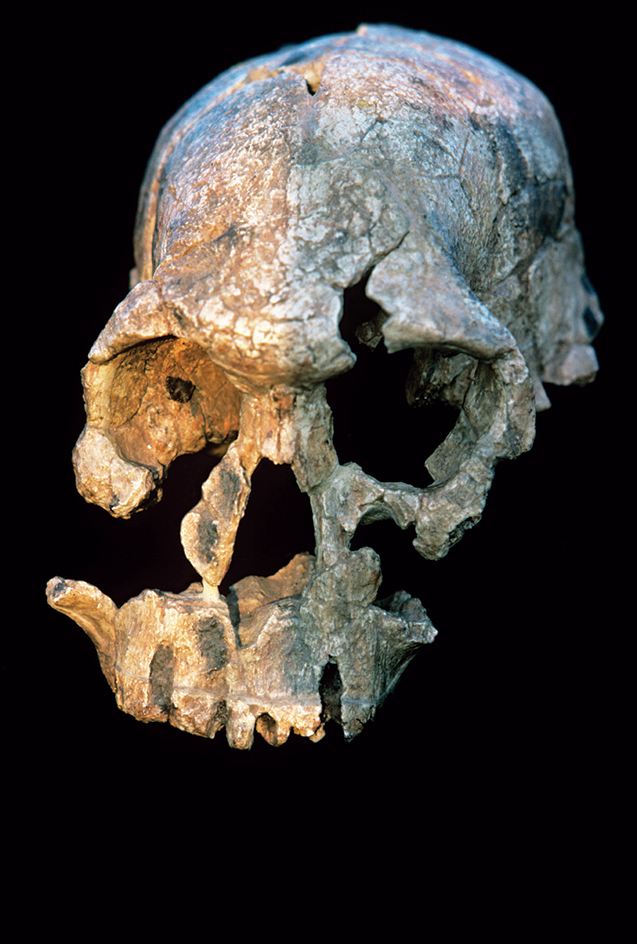
Paleoanthropologists disagree about whether H. habilis and H. rudolfensis were two different species or whether the fossils represent natural variation among individuals of a single species. A large source of such variation is the difference in size and shape between males and females, known as sexual dimorphism. Sexual dimorphism in terms of size appears among many modern apes and was present among the australopithecines. Such dimorphism is less pronounced in modern humans.
Homo erectus.
Another species of early human being, Homo erectus, appeared about 1.8 million years ago. The term erectus refers to the upright posture of these creatures. Most scientists believe H. erectus survived for more than 1 million years and that this species eventually gave rise to modern people.
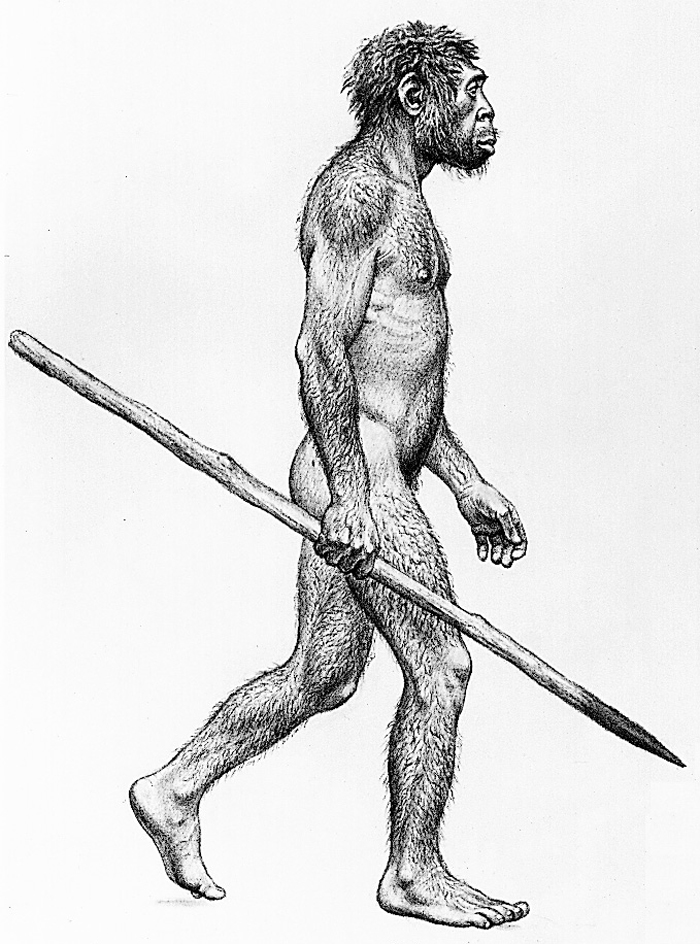
The earliest Homo erectus fossils had a brain slightly larger than that of H. rudolfensis but had smaller molars. These individuals differed greatly from modern people in the shape of the skull. Homo erectus had a thick skull, sloping forehead, and large jaw without a chin. Its skull had a browridge, a raised strip of bone across the lower forehead. H. habilis and H. rudolfensis had long faces that projected forward. H. erectus had a smaller face with a more vertical orientation.
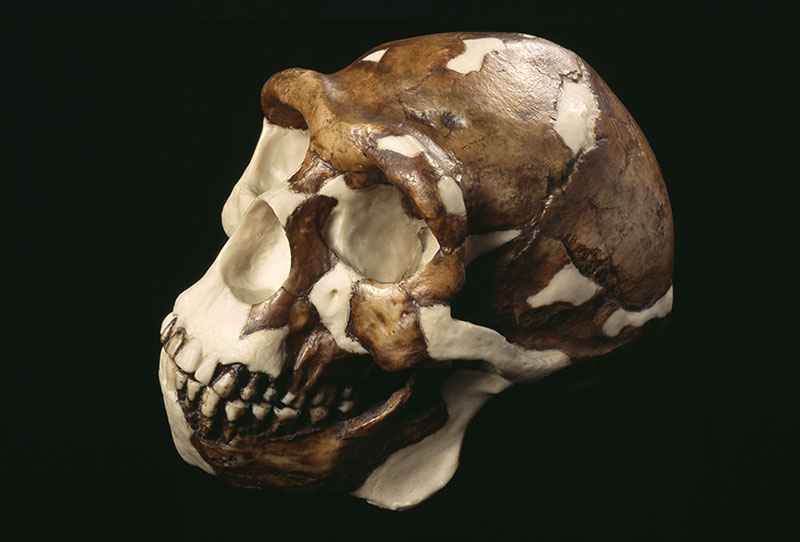
One of the best examples of H. erectus is the nearly complete fossil skeleton of a boy who was probably about 11 or 12 years old when he died. The skeleton, more than 1.5 million years old, was found near Lake Turkana. The boy had grown to about 5 feet 3 inches (160 centimeters) in height and would have grown taller if he had lived to adulthood.
How the first people lived
Toolmaking.
Early humans, including H. habilis, H. rudolfensis, and H. erectus, made and used stone tools. Prehistoric people made tools out of rock by striking one stone with another, chipping away pieces to produce a cutting edge. Such tools were used to cut and scrape meat and plants for food and to chop into bones to eat the marrow inside. The first tools were crude, but over time early human beings began to craft tools of a finer quality. Later toolmakers used mallets of wood or bone to tap away small chips of stone, producing a straight, sharp cutting edge.
Scientists think early human beings ate meat in addition to fruits, insects, and plants. Archaeologists have found animal bones buried with stone tools from the time of the first people. Some bones show scratch marks that were probably made by the cutting action of stone tools. These marks indicate that the early butchers used tools to cut up game and to scrape meat off bones.
Later in the time of Homo erectus, tools were more skillfully made, and new types of tools appeared. For example, H. erectus created double-edged cutting tools of stone called hand axes. Workers probably held these axes in their hands, without a handle, and used them for many tasks, such as shaping wood or bone and cutting meat. H. erectus may have hunted large animals.
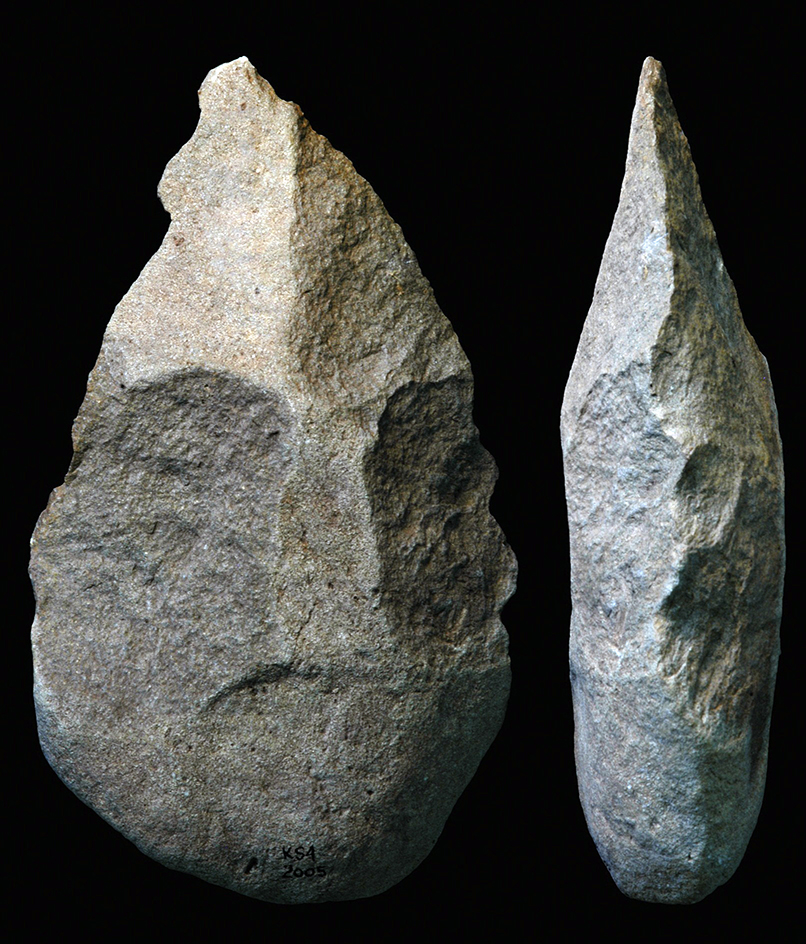
The use of fire.
Homo erectus was probably the first human being to master the use of fire. Scientists believe that as H. erectus moved into northern areas and faced cold winters, fire and clothing became necessary. Archaeologists have not found any traces of early clothing, but it was probably made from animal hides. The oldest evidence of the use of fire is found in a cave that H. erectus occupied between 600,000 and 400,000 years ago, near what is now Beijing, in northern China. Stone tools and the remains of more than 40 H. erectus individuals were found in the cave, along with burnt animal bones.
Migration from Africa.
Homo erectus was the first hominin species to migrate out of Africa. Anthropologists think early people first migrated from Africa sometime after 1.8 million years ago. Paleoanthropologists have found hominin fossils along with stone tools at Dmanisi << deh mah NYEE see >>, a site in what is now the Republic of Georgia. The evidence suggests that these people’s larger brains and use of tools enabled them to colonize new areas. Paleoanthropologists think the earliest fossil remains of Homo erectus on the island of Java, in present-day Indonesia, are also about 1.8 million years old (see Java fossils).
Homo erectus continued to evolve after establishing populations in parts of Africa, Asia, and Europe. Over the roughly 1 million years that H. erectus existed, brain size increased. By the time H. erectus became extinct, individuals had brains nearly as large as those of small modern humans. They also showed wide variation in body size. Some H. erectus were tall and slender, and others were short. The range of physical variation among H. erectus was similar to that among modern humans.
Massive glaciers repeatedly covered much of Europe and northern Asia during the ice ages of the Pleistocene Epoch, from about 2.6 million to 11,500 years ago. Changes in glacial coverage caused early human populations to move into and out of Europe and the northernmost parts of East and Central Asia many times. People could not have survived in most areas of Europe during times of maximum glacial coverage. The oldest fossil remains of early humans in Europe are known from sites in the Atapuerca Mountains in northern Spain. The site is 1.2 million years old. But scientists are uncertain how the fossils found there are related to later humans of Europe or of other parts of the world.
In 2004, scientists announced the discovery of a possible new species of human being whose adults were little more than 3 feet (90 centimeters) tall and had a brain about one-third the size of a modern human brain. The new species, named Homo floresiensis << flaw REHS ee ehn sihs >>, lived on Flores Island in Indonesia as recently as about 50,000 years ago. H. floresiensis may have descended from a group of early human beings that migrated from Africa and became isolated on the remote island. In such a place, the group could have gradually evolved a smaller body size. Some scientists argue that the fossils require further study, however, to determine how H. floresiensis relates to other humans. 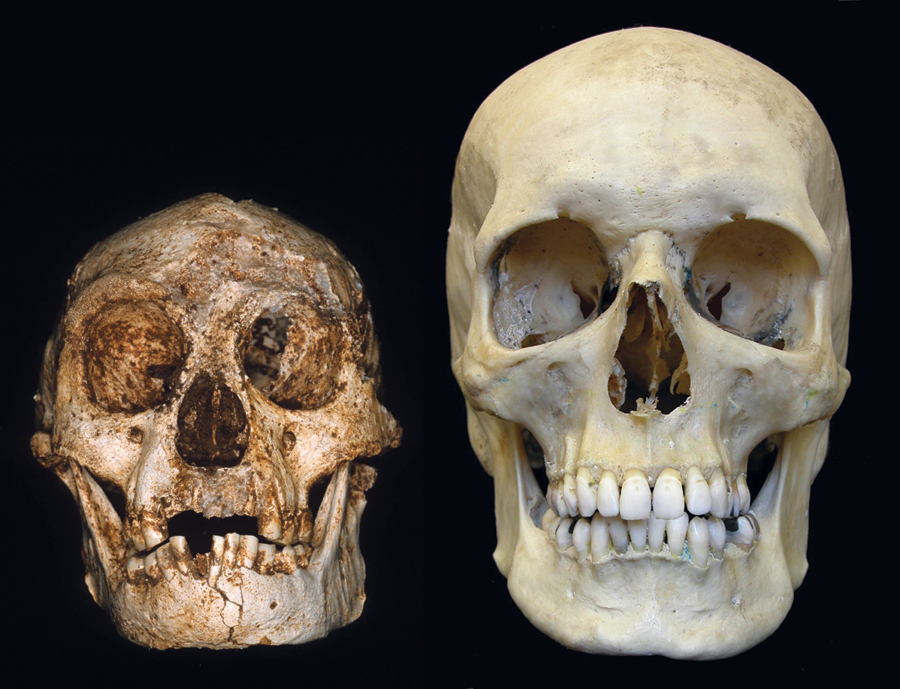
The origin of Homo sapiens
Scientists classify modern people as Homo sapiens, a term that means wise human being. Compared with the earliest human beings, people today have a high forehead and a higher and more rounded skull. They lack the browridge of earlier people, and they have a chin and a smaller, flatter face.
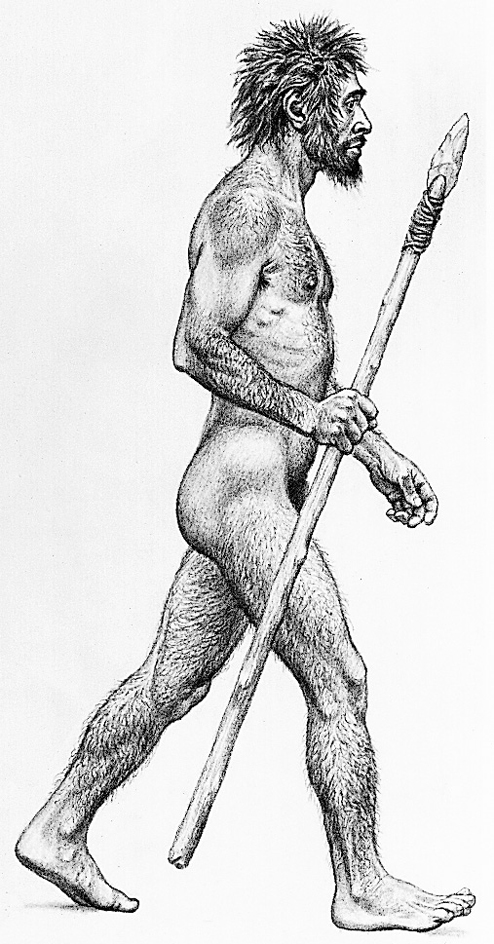
Humans today are physically diverse, with people in different parts of the world looking different from one another. Many of the different traits relate to the climate in which people live. For example, darker skin colors are found mainly among people whose ancestors have lived in warm tropical climates, such as Africa, southern Asia, and Australia, for many generations. Their darker skin evolved over time as an adaptation to higher levels of ultraviolet (UV) radiation. UV radiation is a component of sunlight that can damage the skin. Likewise, people today vary in the width of their bodies. Among some peoples, this variation relates to the climate. Some populations living in colder climates, for example, have evolved a wider body over many generations. Such a body shape retains heat more effectively. See Races, Human (Climatic adaptations).
Physical variation among individuals requires the scientific conception of Homo sapiens as a species to include many anatomical forms. Paleoanthropologists studying the origins of Homo sapiens concentrate on those physical features that distinguish modern people from earlier humans. These features relate mostly to the size and shape of the brain, skull, and jaw.

Scientists today study the origin of Homo sapiens using fossil and genetic evidence. Fossils provide information about the anatomy of prehistoric people. Genetic evidence comes from DNA, found within the body’s cells. Under certain conditions, DNA is preserved within ancient remains as well. This DNA enables scientists to compare the relationships of living and prehistoric people. The study of prehistoric DNA and genes is called paleogenetics.
Geneticists have found that all humans alive today are closely related to one another. That is, there are few differences in DNA among human individuals, no matter where they live. The genetic diversity among modern humans is much less than that found in other primate species, such as chimpanzees or gorillas. Among living humans, however, Africa features greater genetic diversity than any other area. This evidence indicates that modern humans have existed in Africa for a long time, enabling more genetic differences to accumulate. The similarity among living people and the greater diversity of African peoples indicates that Africa had a central role in human ancestry.
Analysis of preserved DNA has transformed the way that scientists understand relationships among ancient humans. In the past, scientists classified most ancient humans into different species based on differences in physical appearance. In biology, two living things are traditionally considered to be different species if they do not interbreed in their natural habitat. Today, scientists understand that ancient groups of humans were not prevented from breeding with one another. Instead, ancient human populations interbred and are ancestral to living humans. Homo sapiens represents only a fraction of the diversity that existed among humans in the distant past. Some scientists prefer to classify different ancient human populations into our own species, Homo sapiens. Others classify various ancient humans into species different from our own.
Archaic humans.
Paleoanthropologists refer to people living today as modern humans. They recognize that human populations that lived after Homo erectus, but more than about 100,000 years ago, were physically different from modern people. While these ancient humans had brains about the same size as do people today, their skulls were shaped differently. They generally had thick skull bones, a larger and more protruding face, a browridge over the eyes, and a low forehead. Many of them lacked a chin. Paleoanthropologists refer to these physically distinct early people as archaic humans. The term archaic means old or ancient.
Through studies of the fossil record, scientists know several kinds of archaic humans from regions of Africa, Asia, and Europe. These archaic humans include the species Homo heidelbergensis, which followed Homo erectus in many parts of the world. Two other kinds of archaic human known from the fossil record are Neandertals and Denisovans. Scientists are constantly discovering new information about how these populations lived and interacted and how they are related to one another and to modern humans.
Homo heidelbergensis
is the scientific name given to archaic humans who lived in Europe, Africa, China, and India. They are known from fossil sites that date between about 700,000 and 200,000 years ago. Some scientists think that the fossils called H. heidelbergensis may actually represent more than one species. Anatomically, these archaic humans differ from H. erectus in having brains nearly as large as those of people today. Their skulls have higher foreheads and a more rounded shape compared with H. erectus, and a flatter face more like that of modern humans. H. heidelbergensis made stone tools similar to those made by H. erectus.
Neandertals
were a group of archaic humans who lived in Europe and Central Asia. They are known mainly from fossils that date between about 150,000 and 39,000 years ago. The term Neandertal, also spelled Neanderthal, comes from the Neander Valley near Düsseldorf, Germany. The first Neandertal fossils were found there in 1856.
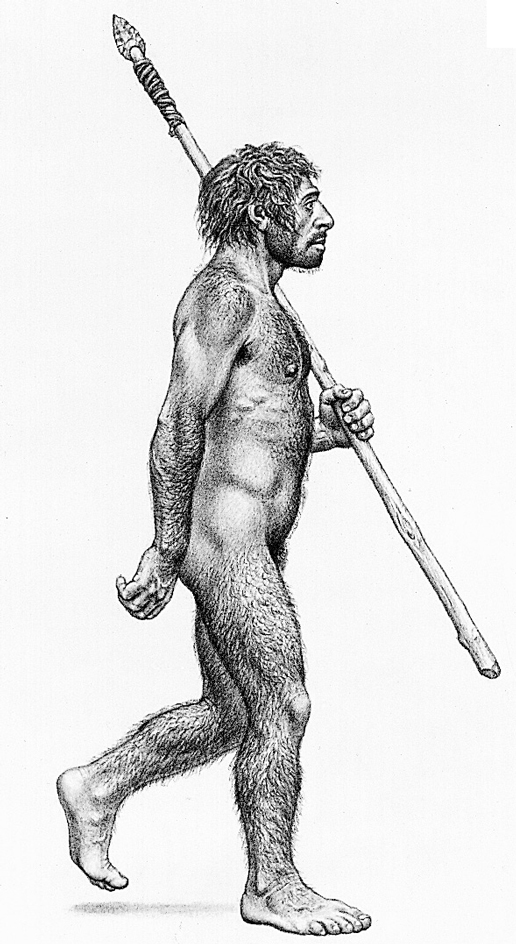
Scientists know much about Neandertal anatomy because a great number of fossils have been recovered. Neandertals sometimes buried their dead. This practice increases the chance that the skeleton will be preserved as a fossil. Paleoanthropologists excavating sites in Europe and the Middle East have uncovered the carefully buried skeletons of Neandertal women, men, and children. At other sites, scientists have found bones of Neandertals that were chewed by carnivores before they fossilized. Some Neandertal fossils show evidence of cut marks made by stone tools. The presence of cut marks suggests that they were eaten by other Neandertals.
Scientists know from studying Neandertal skeletons that these archaic humans were well adapted to living in a cold climate. They lived at a time when vast sheets of ice covered many northern parts of the world. Neandertals had a wide trunk with short arms and legs. Scientists know such a body type retains heat well and serves as an adaptation to harsh winter conditions. Unlike modern people, Neandertals had a long skull and a large face with thick browridges. The Neandertal cranium (braincase) was larger on average than that of modern humans. However, paleoanthropologists think the large size may simply be due to Neandertals’ larger body mass and muscular build.
Many fossils of prehistoric humans are known from cave sites in the Atapuerca Mountains of northern Spain. One cave is known as Sima de los Huesos (Pit of the Bones) because the fossils were found in a deep pit inside the cave. The pit contained the bones of more than 28 individuals who lived around 400,000 years ago. Scientists have concluded that the bones were probably thrown into the pit by other people. The bones’ appearance and a partial DNA analysis of one of the fossils suggested that these fossils were from an H. heidelbergensis population among the ancestors of the Neandertals and Denisovans. In 2016, however, analysis of additional DNA from the fossils showed that the Sima de los Huesos people represent an early population of Neandertals.
How Neandertals lived.
Neandertals were more skilled at hunting and toolmaking than were earlier hominins. They fashioned sharp stone points to fasten onto wooden spears. The bones of many animals have been found at Neandertal sites. Some of the finds show that these people hunted such large animals as horses, reindeer, and mammoths. Neandertals also sometimes captured hares, birds, and other small animals. Neandertals made a variety of stone tools for butchering animals, preparing vegetable foods, scraping hides, and carving wood. Plant remains are not often preserved at archaeological sites. But scientists have discovered traces of plant foods preserved in hardened plaque built up on Neandertal teeth. Plaque is a sticky mixture of food particles and bacteria.
Archaeologists have found most evidence of Neandertals in the entrances of caves, where many of these people lived to shelter from the extreme cold. Archaeologists have also discovered ancient sites where Neandertals camped in the open. Neandertals sometimes pitched large circular tents around a central hearth. The tent covering probably consisted of animal hides, leaves, or bark and was supported by wooden posts.
Neandertal genome.
Scientists have been able to extract DNA from Neandertal fossils. By 2010, scientists in Europe had sequenced an entire Neandertal genome. A genome is a living thing’s complete set of genetic material. The scientists found that the Neandertal genome is more similar to the genomes of native peoples of Europe, Asia, and the Pacific Islands than to genomes of modern people from Africa. Among these non-African people, however, between 1 and 4 percent of the genome comes from Neandertals. This finding strongly suggests that Neandertals interbred with physically modern humans who migrated out of Africa in the distant past.
Denisovans
were a population that lived more than 50,000 years ago in Asia. They are known only from a few skeletal remains—a single finger bone and two teeth. The remains were named after the site where they were found, Denisova Cave, on the Anuy River in the Altai Mountains of southern Siberia. In 2010, scientists examined DNA recovered from the fossils. The DNA sequences differed considerably from those of living people and were easily distinguished from that of Neandertals. The scientists realized that the fossils represent a previously unknown population of archaic humans. Scientists did not expect to discover this ancient group of people. They had never before identified a prehistoric human population through DNA analysis alone.
Denisova Cave also preserves stone tools and other archaeological evidence from other ancient people that lived there over the last 120,000 years. Scientists have concluded from DNA evidence that Denisovans shared a common ancestor with living humans around 500,000 years ago. Denisovans appear more closely related to modern humans than to Homo erectus, the human species that first migrated to Asia more than 1 million years earlier. Without more fossils, however, scientists cannot say what the Denisovans looked like or how widespread was the population.
Scientists have found that some aboriginal peoples of Australia, New Guinea, and islands of the western Pacific have a small percentage of Denisovan DNA in their genomes. This evidence shows that, like Neandertals, the Denisovans interbred with modern humans and were among the ancestors of some living populations.
Modern humans.
Fossil evidence indicates that physically modern Homo sapiens first appeared in Africa. In 1967, paleoanthropologists discovered two fossil skulls at a site called Omo in Ethiopia. The fossils date to about 195,000 years ago. Two other fossil skulls from Herto, Ethiopia, both about 160,000 years old, also show many similarities to those of living human beings. Similar fossils discovered in 2017 at Jebel Irhoud, Morocco, date to nearly 300,000 years ago. Several other sites across Africa have produced fossil evidence of early modern humans who lived before 100,000 years ago.
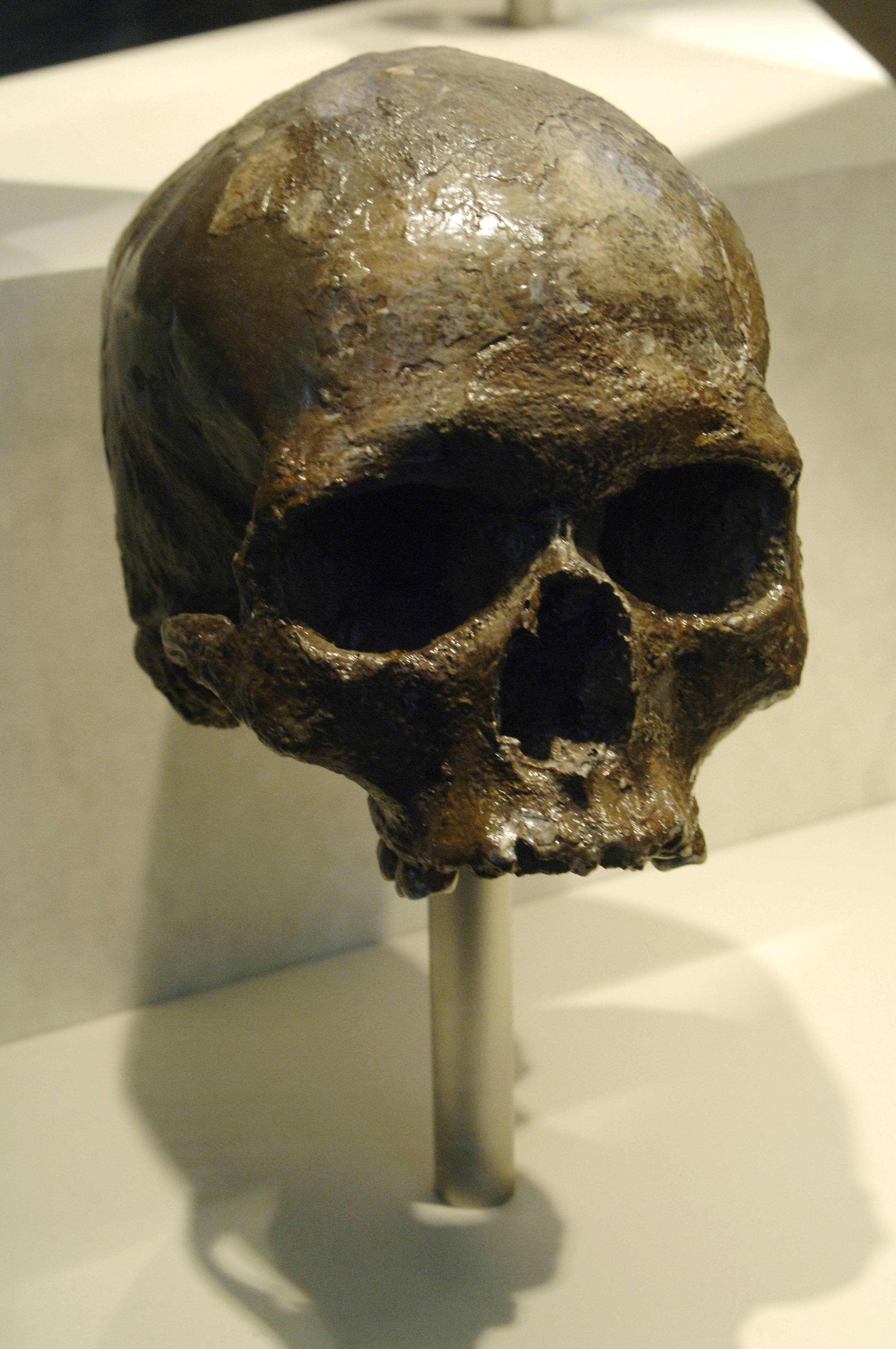
The modern human fossils differ from those of archaic humans mainly in the anatomy of the skull. Modern humans are recognized by the presence of a chin, a vertical forehead, and a smaller, less-protruding face compared with archaic peoples. The modern fossils lack the large browridge seen in archaic people and have a higher and more rounded skull. The earliest modern humans were not identical to living people in Africa today. However, paleoanthropologists believe the anatomical features of these humans indicate that they were ancestors of living people throughout the world.
These modern humans of Africa made stone-pointed spears and cutting tools much as did Neandertals and other archaic humans. The modern humans lived by hunting and collecting wild plant foods. They also made objects that they could wear as ornaments, such as beads and pendants carved from ostrich eggshell. In southern Africa, ancient people of this period made geometric designs on stones and ostrich eggshells. Such ornaments are not found at archaic humans sites.
Modern humans eventually spread beyond Africa. In 2019, scientists determined that physically modern human skull fragments discovered in the 1970’s in a cave in Greece were about 210,000 years old. Some of the oldest evidence of modern humans outside Africa comes from cave sites in Israel. In 2018, scientists published their discovery of a modern-looking partial jaw at Misliya Cave that dates to about 194,000 years ago. At two other sites in Israel, called Qafzeh << KAHF zuh >> and Skhul << skool >>, archaeologists excavated fossil skeletons of modern-looking human beings that date from about 100,000 years ago. At another site nearby, called Kebara, a Neandertal skeleton that dated from about 60,000 years ago was found. This fossil evidence shows that Neandertals lived in the Middle East after modern human beings appeared in the region. This region of the world may have been an important point where people moving from Africa met and interbred with Neandertals. Such interaction may explain the small percentage of Neandertal DNA in living people in these parts of the world.
Modern humans later spread throughout Asia and Europe. They reached what are now India and southern China before 70,000 years ago. They crossed deep water straits to Australia, probably more than 65,000 years ago. They also entered Europe around 45,000 years ago.
The last Neandertals in Europe died out after 39,000 years ago, leaving only modern humans living there. From the ancient DNA evidence, scientists know that modern humans interacted with Neandertals and Denisovans and sometimes interbred with them. Humans today have only a small fraction of DNA from these archaic human populations, which suggests that the interactions were limited. But scientists have found that a few genes from these archaic populations have important functions in modern people.
The Stone Age
Most prehistoric tools that have been found are made of stone. Thus, much of the prehistoric past is often called the Stone Age. The earliest toolmakers may also have used wood and other materials, but no tools made of those materials have survived. The oldest known stone tools were discovered at a site called Gona in central Ethiopia. They are about 2.6 million years old. However, no hominin fossils were found with these tools, so scientists do not know whether the tools were made by an australopithecine or another type of early hominin.

The first part of the Stone Age is called the Paleolithic Period. It began with the first toolmaking over 2 1/2 million years ago and lasted until about 10,000 years ago, when some people in the Middle East began farming. On the basis of toolmaking techniques, scientists divide the Paleolithic Period into three parts. From the earliest to the latest, they are called the Lower, Middle, and Upper Paleolithic. Archaeologists most often use those terms to describe periods of European prehistory.
Even after some people learned to farm, many others continued to live by gathering wild plants and by hunting. These Stone Age hunters and gatherers who lived after 10,000 years ago are called Mesolithic people. Farmers from this period are called Neolithic people.
Throughout the early stages of human evolution, the rate of cultural change among prehistoric people was extremely slow. At times, stone tools and other products of human skill remained unchanged for many thousands of years. The cultural activities of the first physically modern people resembled those of the Neandertals and other early people who lived during that time. For example, the modern-looking human beings from the 100,000-year-old sites of Qafzeh and Skhul were found with the same kinds of stone tools that Neandertals used at sites nearby. Thus, the appearance of modern human beings did not represent a sudden change in lifestyle or culture from earlier people. About 35,000 years ago, however, the rate of cultural change began to accelerate rapidly. This later period is generally referred to as the late Stone Age, or, in Europe, the Upper Paleolithic.
The improvement of tools stands as a major accomplishment of late Stone Age people. New tool types and methods of toolmaking developed at a rapid pace. Stone tools made during this time were more refined and complex in design. Toolmakers invented new devices to serve specialized carving, cutting, and drilling functions. Tools of bone, ivory, and horn also came into use. Archaeologists have found harpoons, fish spears, and needles made from bone that date to this period. These tools suggest the introduction of such activities as fishing and the sewing of close-fitting clothes.
Upper Paleolithic fossil sites in Europe also indicate that these people had become skillful hunters. Some sites hold the remains of thousands of animals. The bones of mammoths, horses, and reindeer are common.
The Stone Age lasted until bronze replaced stone as the chief toolmaking material. In some areas, this change happened about 5,000 years ago.
The appearance of art
was one of the most spectacular developments of the late Stone Age. The practice of creating art seems to have developed rapidly in Europe, Africa, and Australia. Some of the oldest artworks from the Upper Paleolithic were ornaments, such as beads made from polished shells. After about 30,000 years ago, prehistoric people began to produce a variety of artwork. They excelled at carving—creating beautiful sculptures of animals and people, usually from ivory or bone. They also made engravings of people and other animals on bone, ivory, and stone. Upper Paleolithic people in Europe sculpted clay, ivory, and stone figurines of women, which may have symbolized fertility.
A number of caves in Europe are covered with paintings, drawings, and engravings from the Upper Paleolithic. Most distinctive of these are the paintings, which appear on the cave walls and ceilings. Some of the paintings are of animals early people probably hunted, including bison, mammoths, and horses. Many of the paintings are of a high artistic quality. Paleolithic artists used three basic colors: black, red, and yellow. They obtained these pigments from natural sources, including charcoal, clay, and iron and other minerals.
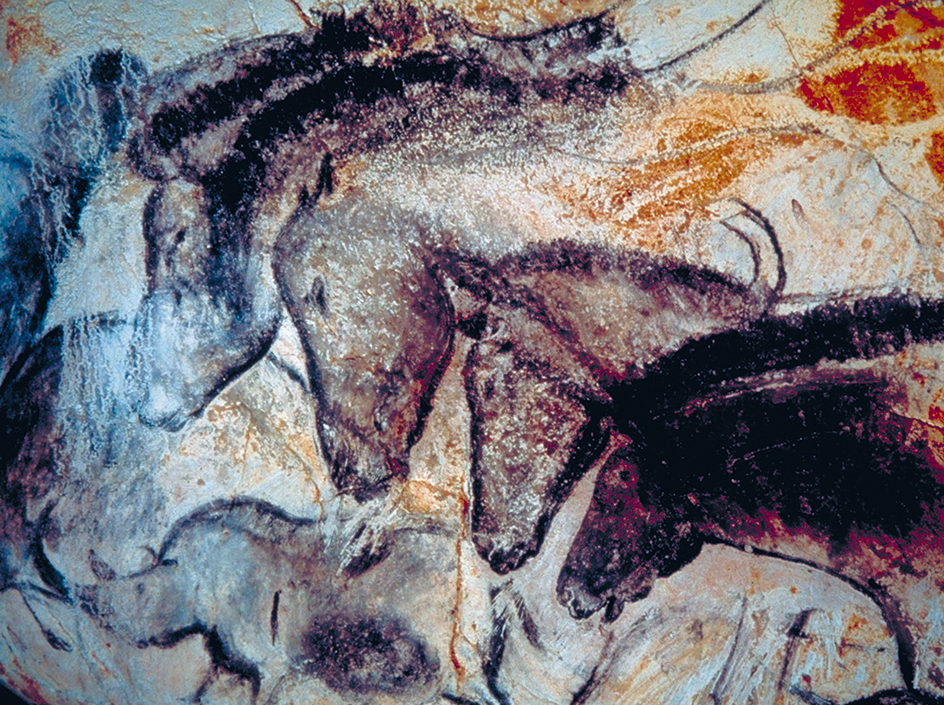
The spread of settlement.
Prehistoric people spread into new areas during the late Stone Age. Cultural and technological advances enabled them to migrate to such places as Australia, the Pacific Islands, and North and South America.
Some time before about 65,000 years ago, people used boats to reach Australia. About 20,000 years ago, people from Australia and Asia began to colonize Pacific Islands. These people employed sophisticated navigational systems combining knowledge of the stars, water currents, and wind direction with the use of simple navigational tools.
By 130,000 years ago, humans had spread to the cold, harsh plains of western Siberia, but not until later did people move into the eastern part of the region. At that time, because so much water had been frozen as glacial ice, the level of the oceans and seas was lower than it is today. As a result, the Bering Strait was dry and formed a land bridge between northeast Asia and North America. Scientists believe people crossed this bridge into North America by about 15,000 to 20,000 years ago.
The most recent ice age ended about 11,500 years ago. As the ice receded, the environment of many prehistoric populations changed, greatly affecting their ways of life. In some areas, such as Europe, forests began to spread across the land. The people learned to hunt new species of animals and gather new varieties of plants. In other parts of the world, people began to experiment with methods of controlling their supply of food. They learned that they could plant seeds from the plants they ate. They also learned that they could domesticate wild animals, perhaps by capturing the young and raising them. Domesticated living things have been tamed or cultivated for human use. These discoveries led to farming.
The rise of agriculture.
Early peoples in a number of different regions independently domesticated various crops and livestock. Scientists often call such areas centers of domestication. From these locations, agriculture spread as people migrated to or traded with other lands.
According to scientists, the first domesticated crops probably emerged in the Middle East more than 10,000 years ago, around 9000 to 8500 B.C. The first farmers lived in a region in the Middle East called the Fertile Crescent. People in the Fertile Crescent domesticated barley, lentils, peas, and wheat. They also domesticated goats and sheep and eventually cattle and pigs. At first, these people probably did not depend entirely on the crops they raised. But as they improved their methods, farming became their most important source of food.
China was another important early center of domestication. People there first domesticated millet and rice by roughly 8000 B.C. Inhabitants of the area were also among the first to domesticate chickens and pigs.
People living in the Andes region of South America domesticated squash and other plants by about 8000 B.C. and later domesticated such crops as lima beans, peanuts, and potatoes. Squash was independently domesticated by inhabitants of Mesoamerica (Mexico and Central America) around the same time as in South America. Mesoamericans later domesticated such crops as avocados, beans, and corn. Scientists have identified a small number of additional early centers of agriculture, including some in Africa and one in the eastern United States. These centers began domesticating plants and animals later than the other centers but still played an important role in agricultural history.
Changes in lifestyle.
Prehistoric farmers, called Neolithic people, lived much differently from other late Stone Age people. In some ways, farming made life easier. It provided a steady supply of food and enabled people to live in one place for a long time. But farmers had to work harder than did hunters and gatherers.
Prehistoric farmers set up villages near their fields and lived in them as long as the crops grew well. Most fields produced good crops for a few years. The land then became unproductive because the crops used up nutrients (nourishing substances) in the soil. The people then shifted their crops to new fields. In this way, farmers settled many new areas.
Prehistoric farmers built larger, longer-lasting settlements than the camps that other late Stone Age people had built. In the Middle East, for example, early farmers built their houses of solid, sun-dried mud, sometimes on stone foundations. The early farmers also built fences to confine and protect their livestock.
The end of prehistoric times.
Neolithic farmers made inventions and discoveries at an even faster rate than other late Stone Age people had done. Early farmers developed a number of useful tools. These implements included sickles to cut grain, millstones to grind flour, and polished stone axeheads.
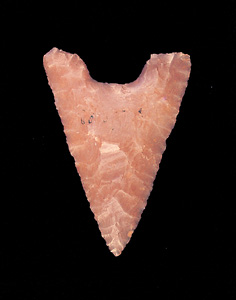
As early as 16,000 B.C. in China and Japan, and later in the Middle East, people discovered how to make pottery. Pottery containers enabled people to carry and boil water easily. Farmers also used pottery to store grain and other food.
The development of farming was an important step toward the rise of civilization. As farming methods improved and food became more plentiful, many people were freed from the jobs of food production. These people developed new skills and trades. In addition, the abundant food supply enabled more people to live in each community. In time, some farming villages became cities. The first cities appeared by about 3500 B.C. These cities were the birthplaces of modern civilization.
Metals became important only after people learned to create bronze, a substance hard and durable enough to make lasting tools. People of the Middle East made bronze as early as 3500 B.C. The Bronze Age started when bronze replaced stone as the chief material used to make tools. In some regions, such as the Near East, the Bronze Age began approximately 3000 B.C.
Archaeologists believe writing was first invented about 3500 B.C. in cities in the Tigris–Euphrates Valley in what is now Iraq. People then learned to record their history, and prehistoric times came to an end.
Studying prehistoric people
Since the mid-1800’s, scientists have learned much about prehistoric people and their ways of life. They have used various methods to obtain this knowledge.
Studying fossils
of prehistoric people has provided anthropologists with much of their most valuable information. Human fossils give direct evidence of what prehistoric people looked like, what they ate, how long they lived, and how their lives differed from ours.
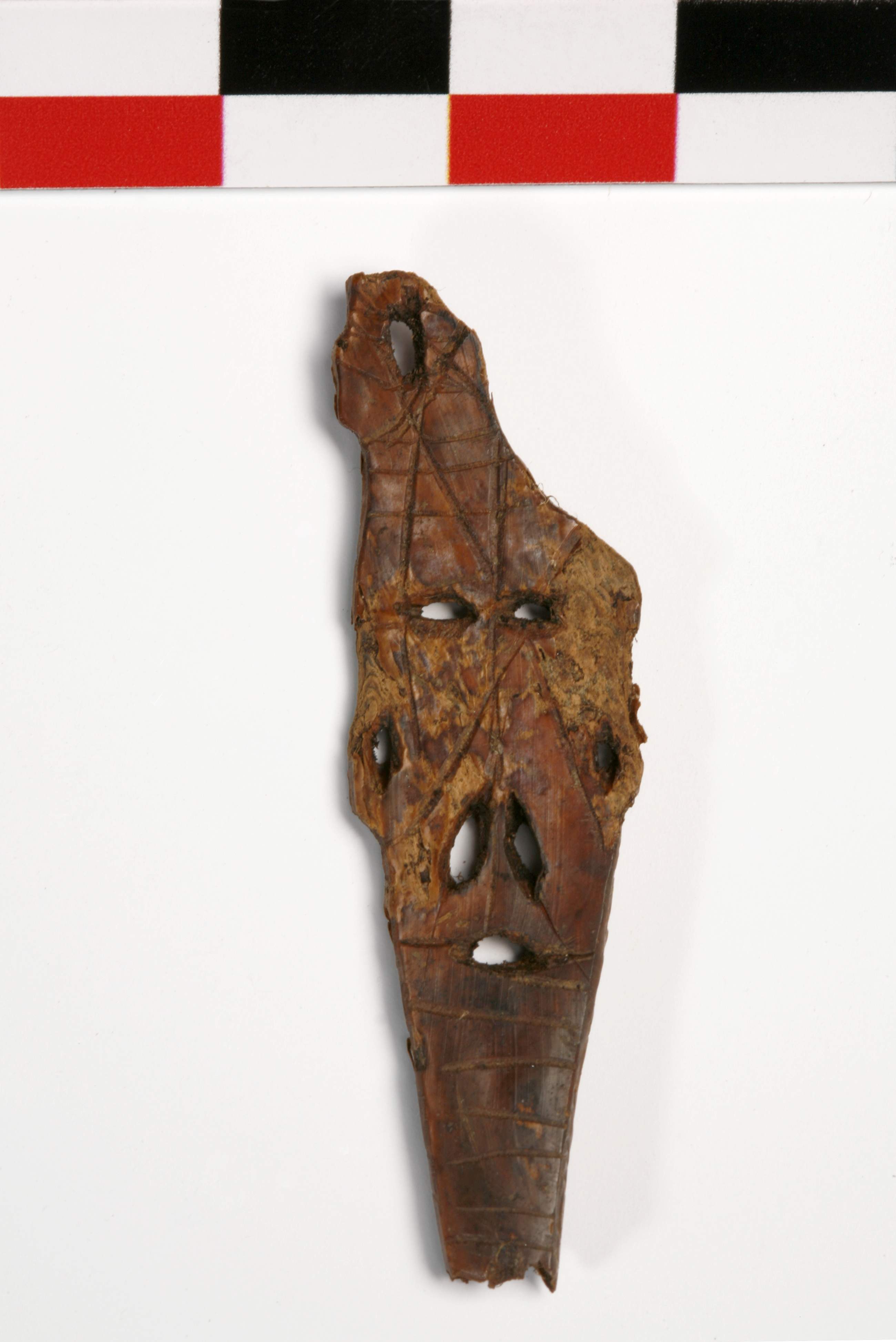
Unfortunately, fossil bones and teeth are scarce. They are rare because certain unusual conditions must be present for a fossil to form. An animal or person must be buried soon after death, and minerals from the soil must gradually replace the bony material to create a fossil. Also, the bones and teeth that do become fossils have often been broken, damaged, or distorted by the weight of the deposits in which they were buried. Soft tissues—such as the skin, hair, and internal organs of prehistoric people—decay without leaving any fossil remains. As a result, scientists cannot determine certain characteristics of early hominins, such as the shape of the nose, the color of the skin, or the texture of the hair.
After a fossil is discovered, scientists first determine whether it came from an adult or a child and whether the individual was a male or a female. Paleoanthropologists then compare the fossil with similar structures from other extinct hominins, living people, and apes. These examinations enable scientists to better understand the specimen’s place in human evolution. Paleoanthropologists try to determine a relationship between the individual’s physical structure and its way of life. For example, looking at the way the teeth have worn down often provides clues about the foods the individual ate. The chemicals in fossil bones can also give clues about the diet of extinct hominins.
Examining prehistoric sites.
Paleoanthropologists spend a large amount of time surveying the landscape in search of prehistoric sites. These sites may be places where prehistoric people camped, made tools, butchered animals, or buried their dead.
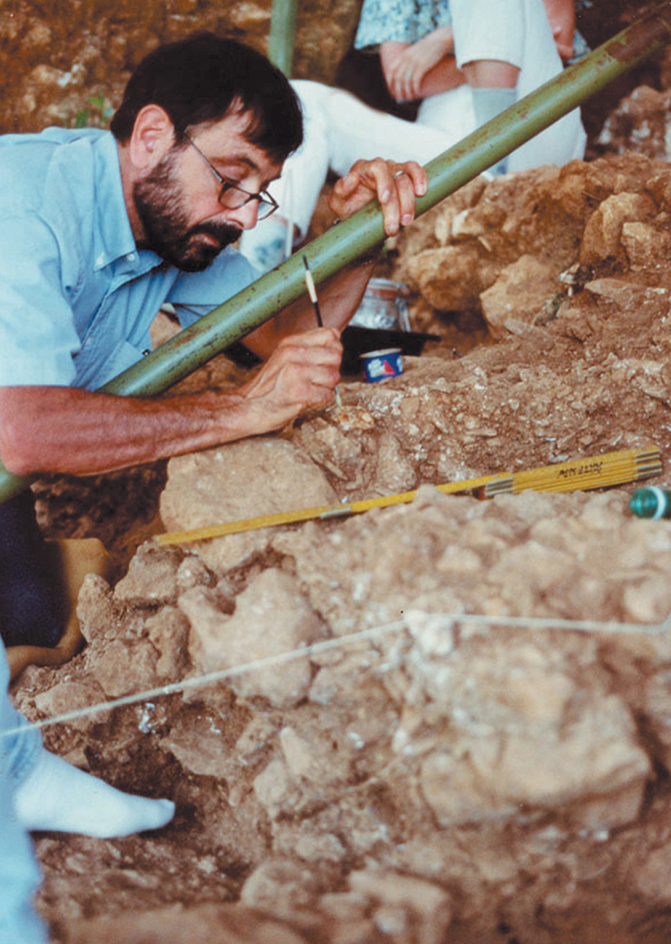
The excavation of prehistoric sites is a complicated process. Archaeologists carefully scrape away soil, sand, or rock to reveal tools, bones, pottery, and other evidence of early human life. They make detailed notes and maps to record the exact position of all important items. They later use these records to precisely reconstruct the layout of the site. By studying the objects they find and the layout of the site, scientists learn how prehistoric people used the site in life.
Placing prehistoric people in time
is an important part of learning about human ancestors. To understand the significance of a newly discovered fossil, scientists must determine how that hominin relates to other hominins. This relationship can be clarified by dating the new fossil—that is, by calculating when the person lived.
Scientists have traditionally dated fossils by studying the deposits in which the fossils are found. Based on knowledge of geological history, scientists can determine the age of a particular deposit. From this information, they can provide an approximate age for the fossil.
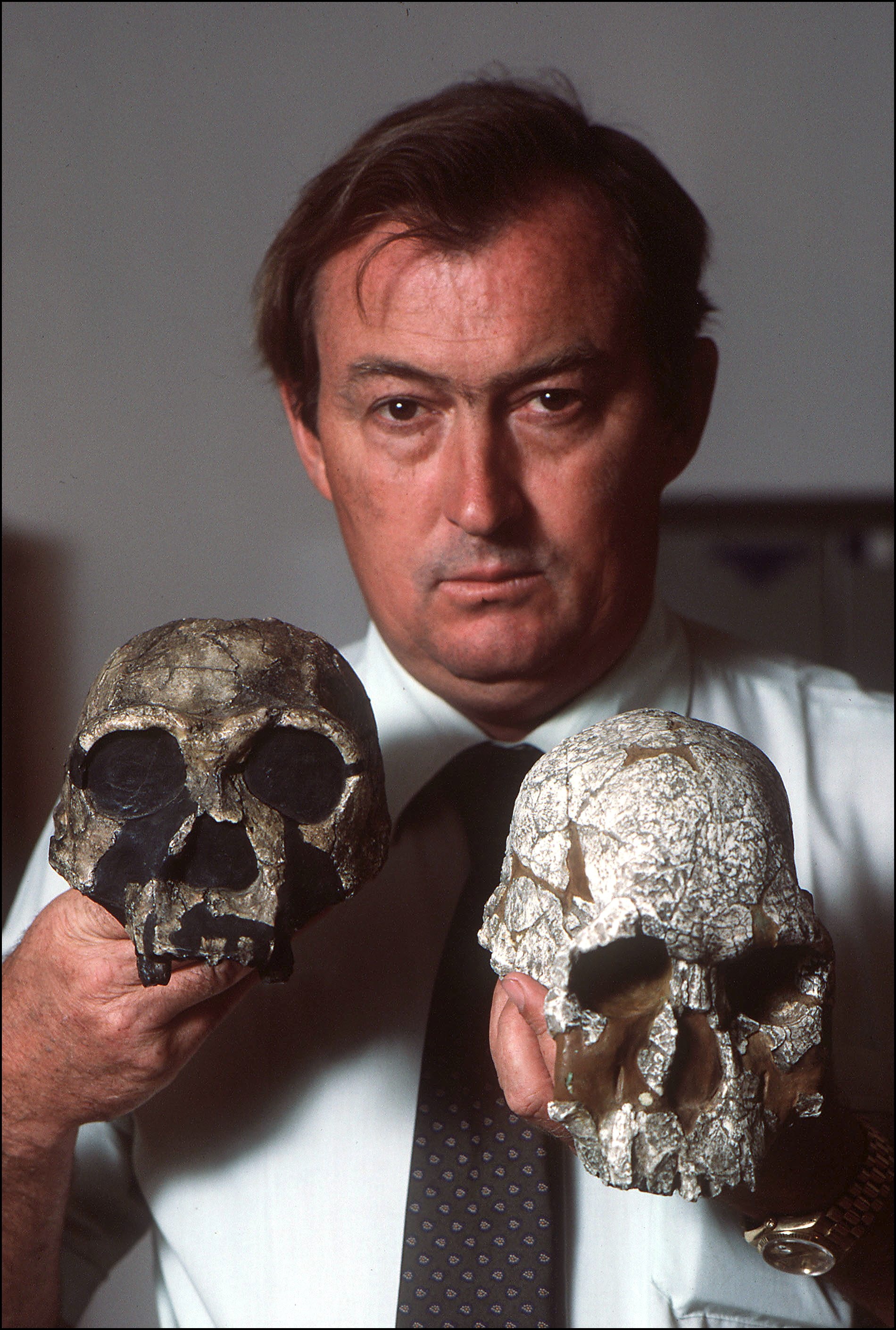

Other dating methods are much more accurate. These methods are based on the fact that certain radioactive isotopes (forms of chemical elements) decay at a known rate to form different isotopes. By measuring the amount of each isotope in a fossil, scientists can determine how long the decay has been going on and therefore how old the fossil is. The most commonly used dating methods of this type are radiocarbon dating and potassium–argon dating. Radiocarbon dating is sometimes called C-14 dating. Potassium-argon dating is also known as K/AR dating. Other dating methods include electron spin resonance (ESR) dating and thermoluminescence (TL) dating. These dating techniques are based on the action of cosmic radiation and radioactive decay on rocks or tooth enamel.
Analysis of the genetic material
of living people is another method of studying prehistoric people. This method largely involves the study of DNA. Geneticists examine DNA from people and compare it with DNA from other people and from apes and other living primates. Such comparisons enable scientists to determine the evolutionary histories of species and groups of people more precisely. Using genetic samples, scientists study how quickly DNA changes during the evolution of humans. From these studies, they have come to understand when we last shared common ancestors with other animals, particularly the apes.
Scientific comparison of the DNA among modern populations has shown that all living people share most of their ancestry with one another. More than 95 percent of the genome of most living people can be traced to Africans who lived between 100,000 and 200,000 years ago. Paleoanthropologists call those early Africans the first modern humans. Scientists have also compared the DNA from Neandertals and other prehistoric peoples to that of living humans. Those archaic humans also figured in the ancestry of living people. However, the percentage of modern human DNA contributed by these archaic people was relatively small.
Most scientists believe that as more is learned from genetic studies, they will be able to determine how physical features are related to specific genes. Scientists will then gain a better picture of how our ancestors evolved over the last 7 million years.
